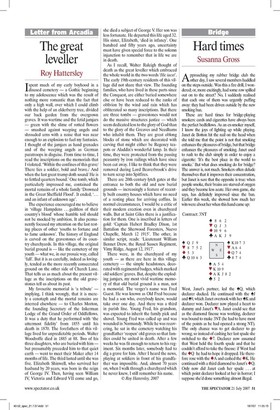The great leveller
Roy Hattersley Ispent much of my early boyhood in a disused cemetery — a Gothic beginning to my adolescence which was the result of nothing more romantic than the fact that only a high wall, over which I could climb with the help of an elderberry tree, divided our back garden from the overgrown graves. It was wartime and the fetid jamjars — green with the slime of rotted flowers — smashed against weeping angels and shrouded urns with a noise that was near enough to an explosion to fuel my fantasies.
I thought of the jamjars as hand grenades and of the weeping angels as German paratroops in disguise. From time to time, I read the inscriptions on the memorials that I violated. 'Within the confines of this grave/ There lies a soldier, bold and brave./ And when the last great trump doth sound/ He is to fettled quarters bound.' One tomb, which particularly impressed me, contained the mortal remains of a whole family 'Drowned in the Great Sheffield Flood'. It ended, `... and an infant of unknown age'.
The experience encouraged me to believe in 'village Hampdens ... guiltless of their country's blood' whose humble toil should not be mocked by ambition. It also permanently focused my attention on the last resting places of other 'youths to fortune and to fame unknown'. The history of England is carved on the gravestones of its country churchyards. In this village, the original burial ground is — like the cemetery of my youth — what we, in our prosaic way, called `full'. But it is as carefully, indeed as lovingly, tended as the more recently consecrated ground on the other side of Church Lane. That tells us as much about the present village as the inscriptions on the old gravestones tell us about its past.
My favourite memorial is 'a tribute' — implying, I think wrongly, that it is merely a cenotaph and the mortal remains are interred elsewhere — to Charles Morton, the founding Secretary of the Inkerman Lodge of the Grand Order of Oddfellows. It was a duty that he performed with 'the uttermost fidelity' from 1855 until his death in 1870. The forefathers of this village lived for unpredictable periods. Walter Woodroffe died in 1885 at 88. Two of his three daughters, who are buried with him — but presumably preceded him to that quiet earth — went to meet their Maker after 14 months of life. The third lasted until she was five. Elizabeth Shinwell, who survived her husband by 20 years, was born in the reign of George IV. Then, having seen William IV, Victoria and Edward VII come and go, she died a subject of George V. Her son was less fortunate. He departed this life aged 32. His sister, Elizabeth, 'died in infancy'. One hundred and fifty years ago, uncertainty must have given special force to the solemn injunction to remember that in life we are in death.
As I recall, Walter Raleigh thought of death as the great leveller which embraced the whole world in the two words 'Hie iacet'. The early 19th-century residents of this village did not share that view. The founding families, who have lived in these parts since the Conquest, are either buried somewhere else or have been reduced to the ranks of oblivion by the wind and rain which has obliterated so many inscriptions. But there are three tombs — gravestones would not do the massive structures justice — which seem dedicated less to the glory of God than to the glory of the Greaves and Needhams who inhabit them. They are great oblong blocks of stone which are decorated with carving that might either be Regency teapots or Aladdin's wonderful lamp. In their time, they were protected from the passing peasantry by iron railings which have since been cut away. I like to think that they were removed during Lord Beaverbrook's drive to turn scrap into Spitfires.
There are 20th-century lytch gates at the entrance to both the old and new burial grounds — increasingly a feature of recently built country houses which have no need of a resting place for arriving coffins. In normal circumstances, I would be a critic of their modern erection even in churchyard walls. But at Saint Giles there is a justification for them. One is inscribed in letters of gold: 'Captain Hubert Bradley Dixon, 1st Battalion the Sherwood Foresters, Nuevo Chapelle, March 12 1915'. The other, in similar script, reads: 'Lieutenant William Bennet Drew, the Royal Sussex Regiment, Vimy Ridge, August 12, 1917'.
There were, in the churchyard of my youth — as there are here in this village cemetery — the simple headstones, decorated with regimental badges, which marked old soldiers' graves. But, despite the exploding jamjars, my most vivid wartime memory of that old burial ground is a man, not a memorial. The verger's name was Fred Guest. He was known as Old Fred because he had a son who, everybody knew, would take over one day. And there was a third in parish line. Young Fred, his grandson, was expected to inherit the family pick and shovel. Young Fred was called up and was wounded in Normandy. While he was recovering, he sat in the cemetery watching his grandfather 'reopen' old graves so that families could be united in death. After a few weeks he was fit enough to return to his regiment. Six months later, somebody had to dig a grave for him After I heard the news, playing at soldiers in front of his grandfather was impossible. And, almost 70 years on, when I walk through a churchyard which he never knew, I still remember his name.
Roy Hattersley, 2007












































 Previous page
Previous page